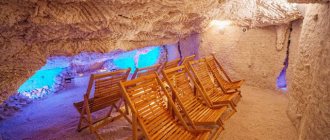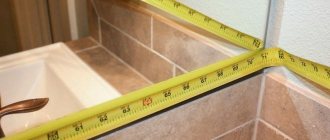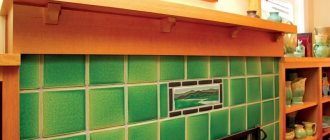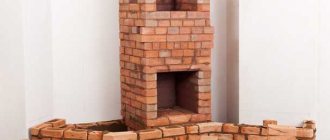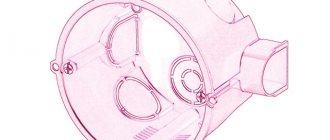Salt bricks for baths have recently gained significant popularity, since its use in arranging premises of this type allows one to achieve a pronounced healing effect.
Salt bricks have the most positive effect on the respiratory system.
Salt brick is a material that has appeared on the market relatively recently. The best slabs are those that were mined in the Himalayan mountains in Pakistan, but at the same time, such salt bricks for baths are quite expensive. Salt bricks mined in the Himalayan mountains have a pinkish tint and create an optimal microclimate that has a truly healing effect.
The thing is that salt vapors have the most beneficial effect on the respiratory system. For example, entire medical complexes are currently being set up in salt mines, where people with severe respiratory diseases, including tuberculosis and bronchial asthma, can quickly undergo the necessary procedures and achieve pronounced remission. Of course, the effect of baths made using such bricks is somewhat less than from visiting salt caves, where nature itself creates an ideal microclimate, but for those who suffer from colds, even staying in a bath can have a significant positive result.
Advantages of salt blocks
The most popular material in the construction industry are salt blocks for baths, which consist exclusively of safe natural ingredients. Today they are used to decorate saunas or bathhouses, as well as to ensure a certain indoor microclimate - like on the sea coast. These products have a number of significant advantages:
- ease of installation;
- long service life;
- ideal for decorative purposes;
- are an environmentally friendly product;
- have a preventive effect against neuroses;
- enrich the air with microelements beneficial to health;
- strengthen the immune system, there is a visible healing effect;
- help in the treatment of diseases of the digestive system and many internal organs.
Products of this type are often used to form light niches in rooms, for air ionization, in medical institutions or catering establishments, as well as for finishing individual flooring.
On the website you can familiarize yourself with the dimensional characteristics and properties of the blocks. If you have any questions about the products, qualified specialists will always provide comprehensive information. You can place an order with our company online or by phone.
Benefits of using salt bricks
Until relatively recently, salt brick was actively used to decorate walls in residential premises and special lamps, which made it possible to improve the microclimate in rooms.
Salt brick is an environmentally friendly material.
Such bricks have a unique natural composition. They consist of 60% sodium chloride, 35% potassium, and about 15% are other complex elements that have a pronounced antibacterial effect. Such additions to the interior can significantly improve the condition of people suffering from frequent respiratory infections, as well as respiratory diseases of an infectious and allergic nature.
Recently, bricks and slabs have begun to be used in the construction of baths and saunas. There are certain subtleties in this matter, because the salt that is used for their production quickly begins to interact with water. Therefore, the relative humidity in the bath should not exceed 53%. At the same time, short-term exceedings of these limits will not have a particular negative impact on this material. In order to get the maximum benefit from using this material, masonry must be done in close proximity to heat sources. The most important advantages of salt bricks include:
- pronounced disinfecting effect;
- improving skin metabolism;
- absolute environmental friendliness;
- ability to withstand high temperatures;
- complete sterility;
- ability to ionize air.
At the same time, it must be taken into account that baths that use salt bricks or slabs require frequent ventilation to create an optimal microclimate, since high humidity has a very negative effect on the condition of such slabs, and a coating that looks very much like frost may begin to form on them. In some cases, to prevent brick destruction, it is advisable to install a ventilation system that allows you to quickly eliminate high levels of humidity.
Himalayan salt in the interior of baths and saunas
Basic principles
In order to make a backlit panel in the steam room, you need to leave a gap of 3-6 cm between the bricks (tiles) and the wall in which the light sources will be located. This gap is necessary, firstly, in order to somehow position the light sources behind the salt, and secondly, so that there is the necessary space for the spread of reflected light. Why exactly reflected? The fact is that if you simply place a powerful light source, it will shine brightly only in one place, that is, it will be point-like. We need to create as uniform illumination as possible. This is achieved only through reflection and re-reflection. The light will be reflected from the foil or film located behind the light sources; be reflected - from the inner surface of the salt itself. How brightly the panel will glow depends on:
- power of light sources;
- the effectiveness of their reflection;
- the thickness of the panel itself.
Everything is clear with the first two points, but what about the thickness? Depending on whether you choose tile or brick, your design will be different.
You can choose a lighting option based on the criterion of replacing light sources: either the element itself is located directly behind the salt, or it is located in another place. Sources that are behind the salt - LED strips (tubes), incandescent lamps; outside the panel there is a projector with an LED that illuminates the panel through an optical fiber. Accordingly, to replace the LED strip, you will need access to its installation site. There are two access options: behind the wall or in front, i.e. dismantling the wall. In the case of fiber optics, the projector must be replaced, which may be located outside the steam room, or under shelves (with a service life of 50,000 hours, this is unlikely to be necessary).
News
Himalayan pink salt is a storehouse of 88 valuable minerals
Himalayan pink salt is one of the latest fashionable “new products” among healthy eating enthusiasts. About the features...
24.10.2019
More details
Salt tiles, bricks with a groove on the profile and for glue
What is Himalayan salt?
Himalayan salt is mined in Pakistan in salt mines located in the Punjab region (300 km from the Himalayas). Hence the name #Himalayan salt. In addition to sodium chloride, this salt contains up to 100 trace elements and minerals. Including potassium, magnesium and calcium.
Although sodium has a bad reputation, it is essential for:
- muscle contraction and relaxation;
- maintaining water balance, preventing dehydration;
- transmission of nerve impulses in cells;
- preventing a decrease in blood pressure.
Benefits of Himalayan salt:
Supports and restores the immune system
When you inhale the tiny particles of salt, it prevents bacterial infection from entering your respiratory tract. Salt destroys fungal infections and other pathogenic microorganisms by activating phagocytes (white blood cells). Relieves fatigue, calms, increases the body's defenses, and promotes overall health of the body.
Reduces inflammation
Studies have revealed the ability of Himalayan salt to reduce swelling of the bronchial mucosa and even relieve inflammation. It really reduces the incidence of respiratory diseases, is effective in the treatment of chronic pulmonary diseases, as well as sinus infections. Himalayan salt removes irritation and inflammation of the respiratory tract caused by tobacco smoke, allergens, and air pollution with harmful substances.
Clears the airways of accumulated phlegm and mucus
Microscopic salt particles contain negatively charged ions. These ions, entering the nasal sinuses and respiratory tract, destroy pathogenic bacteria, suppress the formation of mucus, thereby freeing the nasal canals from congestion.
Detoxifies the body, cleanses it of toxins
The air, especially in big cities, contains a huge amount of pollutants: smog, smoke, dust, various chemicals, allergens. They cause many lung and respiratory diseases: asthma, bronchitis, pneumonia, etc. Help your lungs by using a Himalayan salt ecosystem and filling your home with plants that purify the air.
Improves sleep
When you are sick, coughing, difficulty breathing, snoring turns your sleep into a nightmare. Using an ecosystem or a panel of Himalayan salt will help normalize sleep.
Increases mental activity
By cleansing your lungs by inhaling Himalayan salt, you increase the supply of oxygen to the body, thereby increasing mental clarity and concentration.
Himalayan salt is an effective remedy for chronic skin diseases such as psoriasis, pyoderma, and atopic dermatitis.
In conclusion, we emphasize once again that Himalayan salt has unique healing properties. It is a storehouse of useful substances and a cure for many ailments.
Let's learn how to make a salt room with your own hands: a brief description, methods, nuances and reviews
Salt rooms are otherwise called halo chambers. Many people today know about the benefits of salt procedures. Such preventive zones are often set up in sanatoriums, in the offices of some companies where a healthy lifestyle is encouraged, as well as in respectable restaurants, as an additional service. Firms specializing in the arrangement of such premises will also offer their services to residents of the private sector, who most often do not know how to make a salt room with their own hands.
Video description
For little tricks you need to know when using a wall made of Pakistani salt, watch the following video:
Building a wall
A load-bearing structure made of vertical metal profiles is first mounted on the walls, and horizontal gutters are already installed on them. The tile itself is inserted into these grooves like a panel.
Sauna owners most often choose this method of fixing salt stones for a bath; using fastening glue is considered not a completely reliable method.
However, a special glue based on salt itself and caustic magnesite is used to glue the blocks. They are mixed with water in a ratio of 5:3 or 3:2. The resulting glue is used immediately, within 10 minutes, as it dries very quickly.
For those who do not want to prepare glue themselves, two-component dry adhesive mixtures are sold, which are diluted in water and are used up just as quickly.
Two-component glue Source pechihouse.ru
Using a miracle product in a bath
How to use a healing product in a bath? Everything is very simple. First you need to decide on the type of substance.
Pink Himalayan rock salt flaunts its glory because it contains 85 trace elements that give it powerful healing properties. Sea salt deservedly takes second place; it is indispensable in a bathhouse, as it exudes a relaxing aroma of sea air and has long been famous for its healing effect. The third place is proudly occupied by ordinary, but no less healthy table salt. The main thing is that the product does not contain dyes, fragrances and other harmful substances.
Now let's figure out how to use it. There are 2 methods in demand:
- Scrubbing;
- Inhalation of vapors.
The first method gives an unsurpassed cosmetic effect, and the second a healing one.
Types of illuminated walls
Installation of brick panels using Himalayan salt adhesive
This installation method, in our opinion, is the most preferable: we get a monolithic structure that will hold securely and will not require further maintenance.
With this installation method, it would, of course, be appropriate to use a fiber optic kit with the projector. If you choose an LED strip or tube, you will need to organize access behind the wall (if possible), or accept the fact that when the strip (tube) burns out, the wall will no longer be illuminated.
You can purchase adhesive composition for salt products from anyone who sells Himalayan salt. It is usually mixed with water in a certain proportion, and does not set immediately. After this composition has completely hardened, your wall becomes monolithic. It is important to note that when using bricks, you most likely will not need to prop up the wall while it dries, since the salt brick will be held up due to its width. To fix it in a horizontal plane in the room being used, it is necessary to use support strips from the inside and layouts from the outside.
The finished version looks like this:
Installation of tile panels using Himalayan salt adhesive
Unlike brick, tiles will most likely not hold up when the mortar dries, so the structure must be supplemented with temporary support. You will also need constant support, because even after the mortar has completely set, a tile wall will not be as stable as a brick wall. As a permanent support, you can use a large metal mesh on which the panel will rest.
It is also necessary to provide for attaching the salt panel to the mesh, because we do not have any support in front. In the photo, the salt tile is tied with a nylon thread threaded through a mesh, i.e. we actually tie our panel to a grid, as a result of which it is fixed in space.
Recommendations for the light source are the same as in the first paragraph.
The result will look like this:
"Dry" installation
In our opinion, the least justified type of installation is associated with a number of inconveniences and further maintenance.
I’ll say right away that due to the complexity of maintenance and the unsuitable quality of the source material, we currently do not use this type of installation.
For dry installation you will need aluminum profile guides. Salt products will be installed on them. The guides themselves are attached to the wall through pieces of rectangular aluminum profile. An LED strip or tube is laid in this space.
I note that “dry” installation should be used only if it is not possible to organize access to the backlight from the other side and an LED strip or tube is used as a light source. When using optical fiber, there will be access to the light source because the projector is not behind the salt wall.
To install bricks (tiles) on the profile, you need to make grooves in the bottom and top of the tile.
Since there is no mortar in this design, there are no seams between the products, so each tile must correspond to the stated dimensions and have right angles. In practice, this is observed for a small proportion of products, resulting in the need to adjust each product, which significantly increases the overall installation time.
There is only one advantage here - the ability to replace light sources after dismantling all the tiles or bricks.



